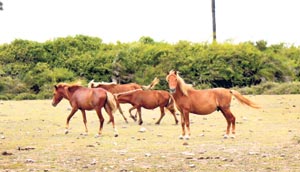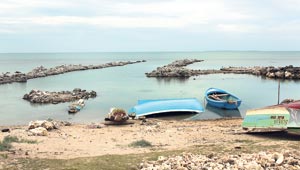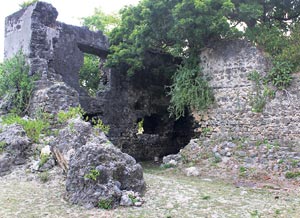The Portuguese called it Ilha das Vacas, the Dutch called it Delft. Locally it is known as Neduntivu. Situated in the Palk Straits, north-west of Jaffna, this island, famed for its wild ponies is the largest in the Palk Strait, estimated to be 4717 hectares, 8 km long and 6 km across.
It is a 40 km journey from Jaffna to the Karaikattuvan jetty where the ferry will take you to the island. The ferry takes around an hour and a half to reach Delft, a distance of 10 km by sea.
 |
| Delft’s wild ponies. |
 |
| Serene shoreline |
 |
| Ruins of the fort |
Huge coral rocks fringe the shores of Delft island. Scorching hot sunlight, wild winds, dry arid land with sparse water are what strike the visitor, but there is a wild beauty about the place that is haunting.
Many of Delft's residents had left due to the war and it is a small population that still lives here. Many children have never visited the mainland and seem afraid of visitors.
There are about nine churches here and the Hindu religion is also practised. There are several fishing hamlets and the communities make dried fish. There is also a post office. The Indian shore is visible from certain points in Delft.
Transport and lodging are hard to come by on the island. The main mode of transport is the bicycle and visitors have to go around in Landmaster mini tractors, a bumpy and bone-rattling ride on the rough terrain.
The waters surrounding the island are turquoise blue and one can wade up to about 300 metres into the sea. There are also fascinating coral formations around. The residents have made their parapet walls out of chunks of these rocks. Huge expanses of Aloe vera grow wild on the almost white sands. As plentiful as the corals are the shells to be found.
The water is brackish and good water wells are very difficult to find. In some areas residents have built tanks and pay for water to be brought by a bowser. They share the water according to the sums paid. But there is also the "Devil's well" - so deep that one cannot imagine that humans dug it, a fresh water well that apparently does not dry-up even in times of drought.
Many in this impoverished community rear goats, cattle and chickens. The houses are basic and one can feel the lack of resources around. But the people are friendly and extremely helpful.
They make oil cakes similar to kavum out of the sap of the palmyra, the palm growing abundantly around. The palmyra toddy of Delft is known to be the best. Many sweets and spicy and savoury fries are made and packeted for sale.
The wild ponies are a legacy left behind by the Portuguese rulers for ponies are not endemic to our country. After the Portuguese left, the Dutch took them over and then the British used them for transport. Delft island was used for breeding horses by the Dutch and the British continued the practice.
The ponies, descendants from the colonial days have a tough time without water. Sometimes during very warm weather, herds of ponies are seen wading into sea. They even loosen the moss on the rocks with their hooves and eat it, when it floats in the water. This is when the drought has parched the grass. Sometimes ponies are found dead for lack of water. Men also lasso the ponies and foals, tame them and thereafter use them for work etc.
The Baobab trees are another legacy of the Portugese who were supposed to have brought it here for medicinal purposes for the ponies. There are several Baobab trees in the island. One in particular is unique as the trunk has a hollow large enough to walk into. Two men can stand abreast in the entrance. Baobab (Adansonia) is native to Madagascar, Australia and Africa.
Another site of interest is the ruins of a castle built by the Portuguese. Also a pigeon house with a stone cote for carrier pigeons, the only means of communication in Portuguese times. The Dovecote, about eight feet in height is made of coral stone. There also are ruins of a Dutch fort, made of dead coral rock.
Another more recent happening is a "growing stone". Measurements taken periodically show a change over the years. The islanders revere it and now have made it a shrine. There is also the "Giant's footprint" engraved on a stone and supposedly a similar footprint exists in the nearby island of Nainativu.
Monkeys, shore birds and land birds, the harmless sand boa python and other snakes can also be found here. Unspoilt and untouched by modernity, Delft island offers a wild experience. |




